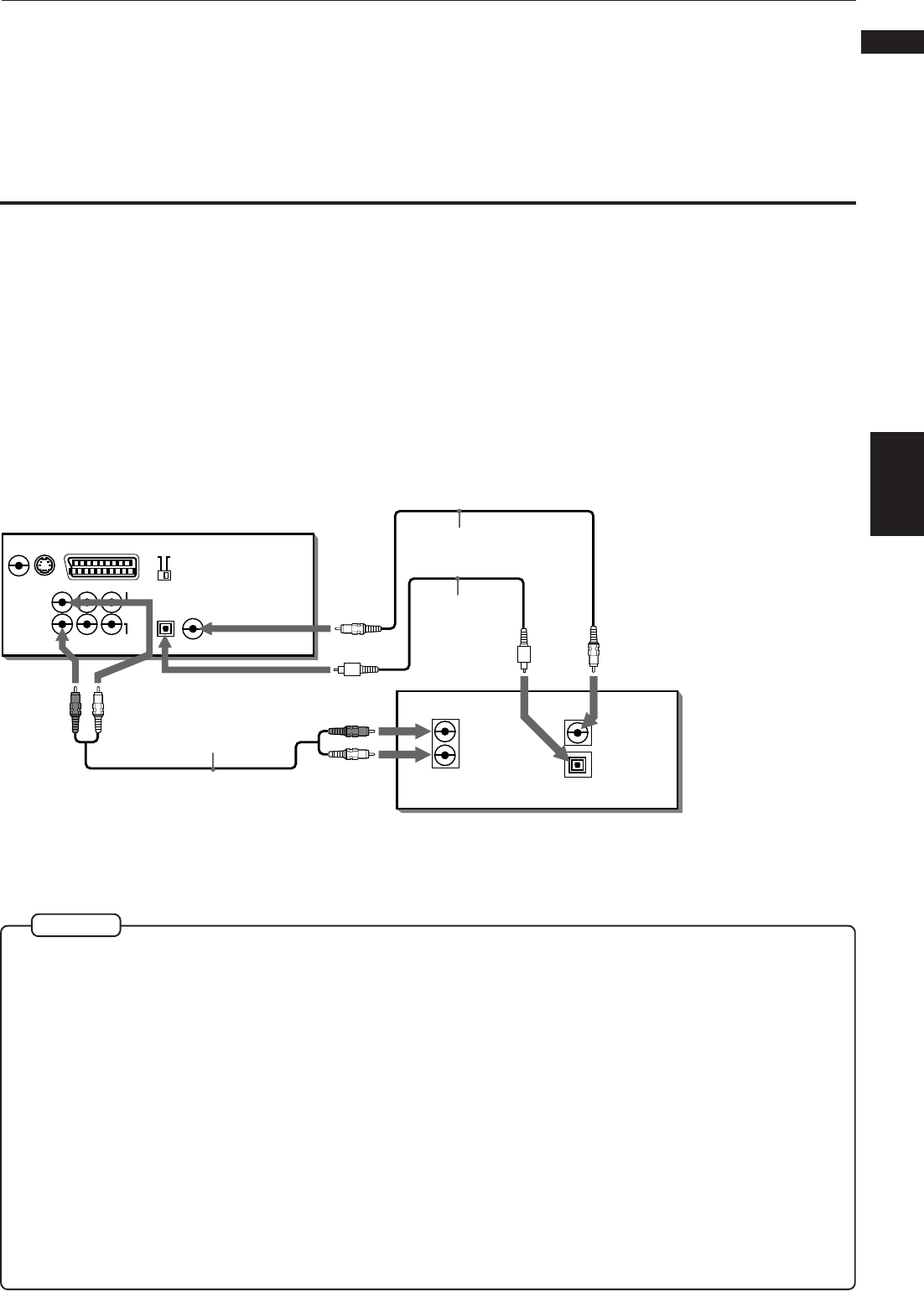
15
Getting started
Getting started
XV-D701BK [B, E] EN
LET0141-003A
English
Français
LEFT
FRONT REAR CENTER
SUBWOOFER
PCM/STREAM
COAXIALOPTICAL
RIGHT
ANALOG
AUDIO OUT
DIGITAL
VIDEO S-VIDEO
AV
VIDEO OUT
AV OUT
COMP.Y/C
IN
DIGITAL
IN
AUDIO
LEFT
COAXIAL
OPTICAL
RIGHT
To connect to audio equipment with a digital input
Connection to a stereo amplifier/receiver (or a recording device such as DAT and MD recorders)
which provides digital stereo input(s), a Dolby Digital decoder (or an amplifier with built-in
Dolby Digital decoder), a DTS decoder (or an amplifier with built-in DTS decoder), or an MPEG
multichannel decoder (or an amplifier with built-in MPEG multichannel decoder).
You can enhance the sound quality by connecting the unit’s DIGITAL OUT (coaxial or optical) to the digital input of an
amplifier, DAT or MD recorder by using an optional digital cable. The digital stereo audio signal from a disc is directly
transferred. If you connect to a Dolby Digital decoder (or an amplifier with built-in Dolby Digital decoder), a DTS
decoder (or an amplifier with built-in DTS decoder), or an MPEG multichannel decoder (or an amplifier with built-in
MPEG multichannel decoder) by usng an optional digital cable (coaxial or optical), you can enjoy high-quality audio
and surround sound. When you make a digital connection, leave the stereo analog audio connection as it is.
Otherwise, depending on the disc type, no audio may be reproduced.
¶ DTS (Digital Theater System)
DTS is a newly-developed surround system which can handle more amount of data than Dolby Digital, providing
better audio quality.
Though the number of audio channels is 5.1 which is same as Dolby Digital, DTS provides fat sound and better
signal-to-noise ratio, thanks to the lower audio compression ratio format. It also provides wide dynamic range
and better separation, resulting magnificent sound.
¶ MPEG multichannel
MPEG multichannel is a surround system format which can handle the augmentative 7.1-channel surround
format, as well as the 5.1-channel format.
¶ When you connect the audio equipment with a digital input, before using, change the “DIGITAL AUDIO OUTPUT”
setting in the “PREFERENCE 2” on-screen display according to the connected audio equipment with a digital
input. When the “DIGITAL AUDIO OUTPUT” setting is not set correctly, loud noise may be played back from
speakers, and it cause of the breakdown of your speakers. See “DIGITAL AUDIO OUTPUT” on page 54.
¶ With this connection, the unit’s settings for "COMPRESSION" and "DOWN MIX" in the "PREFERENCE 2" on-
screen display and the "SPK.SETTING" on screen display are invalid. Settings for these items must be made
from the decoder.
• For digital connection, connect the unit’s DIGITAL out (coaxial or optical) to the digital input of a decoder or an
amplifier with built-in Dolby Digital or DTS or MPEG Multichannel decoder using an optional digital cable.
Audio cable
(supplied)
The unit
A stereo amplifier/
receiver (or a recording
device such as DAT and
MD recorders), a Dolby
Digital decoder (or an
amplifier with built-in
Dolby Digital decoder),
a DTS decoder (or an
amplifier with built-in
DTS decoder), or an
MPEG multichannel
decoder (or an amplifier
with built-in MPEG
multichannel decoder)
Optical digital
cable (not
supplied)
WhiteRed
White
Red
NOTES
Coaxial digital cable
(not supplied)


















